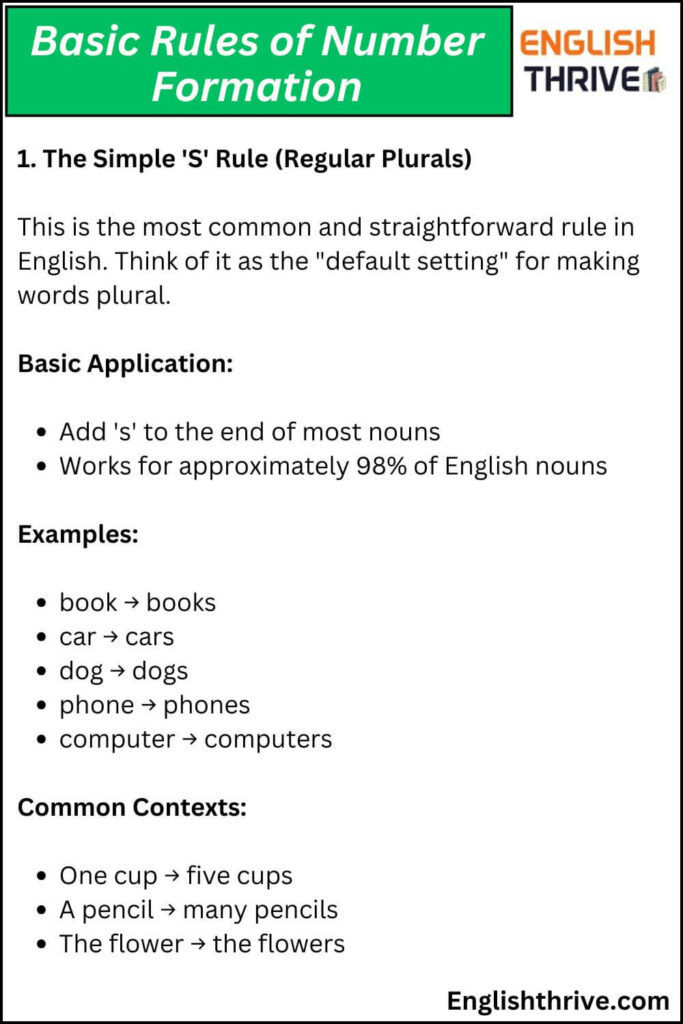Have you ever wondered why we say “one cat” but “two cats”? Understanding numbers in English grammar might seem tricky at first, but it’s actually one of the most fascinating aspects of our language! As someone who’s spent years teaching English, I’ve seen how mastering singular and plural numbers can transform your communication skills.
Let me walk you through everything you need to know about numbers in English grammar, complete with practical examples and exercises that’ll make learning both fun and effective.
Contents
ToggleNumbers in Grammar
Numbers in English grammar are all about showing quantity – whether we’re talking about one thing (singular) or more than one (plural). Think of it like sorting your socks: you have single socks and pairs of socks! The concept seems simple, but it’s an essential building block of English grammar that helps us communicate clearly and precisely.
Understanding the types of numbers
Singular Number
Remember that time you lost just one shoe? That’s exactly what singular number represents – just one of something. It’s used when we’re talking about a single item, person, or concept.
Examples:
- One book sits on the table
- A cat sleeps on the windowsill
- My sister lives in Paris
Plural Number
When you have more than one of anything, that’s when plural numbers come into play. It’s like having a basket full of apples instead of just one.
Examples:
- Books fill the shelves
- Cats roam the neighborhood
- My sisters travel frequently
Basic Rules of Number Formation
Let’s dive deep into the fundamental rules that govern how we form plural numbers in English. I’ll break this down into easily digestible sections with plenty of examples and practical applications.
1. The Simple ‘S’ Rule
This is the most common and straightforward rule in English. Think of it as the “default setting” for making words plural.
Basic Application:
- Add ‘s’ to the end of most nouns
- Works for approximately 98% of English nouns
Examples:
- book → books
- car → cars
- dog → dogs
- phone → phones
- computer → computers
Common Contexts:
- One cup → five cups
- A pencil → many pencils
- The flower → the flowers

2. The ‘ES’ Rule
When words end in sibilant sounds (hissing or buzzing sounds), we add ‘es’ instead of just ‘s’.
Specifically for words ending in:
- s (bus → buses)
- ss (kiss → kisses)
- sh (brush → brushes)
- ch (church → churches)
- x (box → boxes)
- z (quiz → quizzes)
Practical Examples:
- One class → three classes
- A dish → many dishes
- The match → several matches
- A box → two boxes
- The buzz → multiple buzzes
3. The ‘Y’ Rule
This rule has two parts, depending on what comes before the ‘y’:
When ‘Y’ Follows a Consonant:
- Change ‘y’ to ‘i’
- Add ‘es’
Examples:
- city → cities
- baby → babies
- butterfly → butterflies
- story → stories
- lady → ladies
When ‘Y’ Follows a Vowel:
Simply add ‘s’
Examples:
- toy → toys
- boy → boys
- key → keys
- monkey → monkeys
- valley → valleys
4. Common Exceptions to Remember
Some everyday words don’t follow these basic rules:
Words Ending in ‘O’:
- Some take ‘s’: photos, pianos, solos
- Some take ‘es’: heroes, potatoes, tomatoes
- Some can take either: volcano(e)s, mosquito(e)s
Memory Tip: If there’s a vowel before the ‘o’, usually just add ‘s’
5. Self-Check Exercises
Convert these words to plural:
- desk (regular rule)
- watch (es rule)
- baby (y rule)
- day (y after vowel)
- class (sibilant)
[Answers: 1. desks, 2. watches, 3. babies, 4. days, 5. classes]
Pro Tips:
- Read the word aloud to hear if it needs ‘es’
- Look for the letter before ‘y’ to decide the rule
- When in doubt about ‘o’ endings, check a dictionary
- Practice with everyday objects around you
Advanced Plural Formation Rules
Remember how we talked about basic rules being like a recipe book? Well, these advanced rules are like becoming a master chef! Let’s dive into some special cases that make English grammar so interesting.
The F/Fe to V Rule
Here’s a fun one – some words do a little dance when they become plural. Words ending in ‘f’ or ‘fe’ often change to ‘v’ before adding ‘es’. It’s like they’re putting on their party clothes!
Examples:
- leaf → leaves (like autumn leaves dancing in the wind)
- wife → wives
- thief → thieves
- wolf → wolves
- knife → knives
The O-Ending Mystery
Words ending in ‘o’ can be tricky little fellows. Sometimes they just want a simple ‘s’, other times they insist on ‘es’. Let me share a simple trick I use with my students:
For most ‘o’ words:
- After a consonant: Add ‘es’ (potato → potatoes)
- After a vowel: Add ‘s’ (radio → radios)
But wait! There are always those rebels who break the rules:
- Photos (not photoes)
- Pianos (not pianoes)
- Kilos (not kiloes)
Vowel Changes
Some words like to change their inner vowels when becoming plural. Think of it as their internal transformation:
- man → men
- woman → women
- foot → feet
- tooth → teeth
- goose → geese
Compound Nouns and Special Cases
The Man/Men Rule
When ‘man’ means a human being in a compound word:
- policeman → policemen
- fireman → firemen
- chairman → chairmen
But when ‘man’ is just part of the word:
- German → Germans
- Roman → Romans
Compound Word Magic
For hyphenated words, usually the main noun (typically the last word) gets the plural treatment:
- mother-in-law → mothers-in-law
- editor-in-chief → editors-in-chief
Regional Variations
Did you know that British and American English sometimes handle plurals differently? It’s like having two different dialects in the family:
British English:
- maths (plural)
- sports (can be singular or plural)
- team (can be plural)
American English:
- math (singular)
- sport (singular)
- team (singular)
Exercise 1: Basic Transformations
Convert these words to plural:
- box
- city
- knife
- photo
- child
Exercise 2: Sentence Challenge
Correct these sentences:
- The childs are playing with their tooths.
- I saw three deers in the forest.
- There are many mouses in the warehouse.
Exercise 3: Mixed Practice
Choose the correct plural form:
- potato (potatos/potatoes)
- roof (roofs/rooves)
- phenomenon (phenomenons/phenomena)
[Answers provided at the end of the article]
Answer Key for All Exercises
Exercise 1:
- boxes
- cities
- knives
- photos
- children
Exercise 4:
- brothers-in-law
- passers-by
- grown-ups
- commanders-in-chief
- forget-me-nots
Exercise 5:
- children, mice
- ladies, dresses, parties
- wolves, groups
- knives, loaves
- heroes, lives
Exercise 6 Corrections:
- The furniture needs cleaning.
- We bought three pieces of luggage for our trip.
- The information provided was incorrect.
- She has many hobbies including painting.
- The scissors are on the table.
FAQs about Number Definition in English Grammar
Q1: Why do some words like “sheep” and “deer” remain the same in both singular and plural forms?
These words belong to a special category called “zero plurals” or “unmarked plurals.” This pattern exists due to their historical evolution from Old English. In Old English, some nouns belonging to specific declension classes didn’t change form in the plural. Over time, while most nouns adopted the modern ‘-s’ plural, these words retained their original form.
Examples:
- One sheep → Five sheep
- A deer → Many deer
- One species → Multiple species
- One aircraft → Two aircraft
- One fish → School of fish
Q2: How do I handle plural forms of abbreviations and numbers?
The rules for abbreviations and numbers have evolved with modern usage:
Modern Style:
- Decades: 1990s, 2000s (no apostrophe)
- Abbreviations: DVDs, PhDs, URLs (no apostrophe)
Traditional Style (less common now):
- DVD’s, Ph.D.’s, URL’s (with apostrophe)
Exception Cases:
- Single letters: Mind your p’s and q’s
- Special cases for clarity: Dot your i’s and cross your t’s
Q3: What’s the rule for making hyphenated compound words plural?
The general rule is to pluralize the primary noun (usually the last word) in the compound. However, there are specific patterns:
Family Relations:
- mother-in-law → mothers-in-law
- son-in-law → sons-in-law
Job Titles:
- editor-in-chief → editors-in-chief
- commander-in-chief → commanders-in-chief
Fixed Compounds:
- forget-me-not → forget-me-nots
- jack-in-the-box → jack-in-the-boxes
Q4: When should I use “fish” versus “fishes”?
This distinction is both scientific and contextual:
Use “fish”:
- Multiple fish of the same species
- General reference to fish as food Example: “I caught five fish at the lake.”
Use “fishes”:
- Different species of fish
- Scientific or taxonomic contexts Example: “The coral reef contains many different fishes.”
Q5: Why do some English words form their plurals by changing vowels (like man/men, foot/feet)?
This phenomenon, known as “ablaut plurals” or “umlaut plurals,” comes from Old English:
Historical Background:
- These changes were regular sound patterns in Old English
- They survived while other patterns disappeared
Common Examples:
- man → men
- woman → women
- foot → feet
- tooth → teeth
- goose → geese
Q6: How do I handle plural forms of words ending in ‘o’?
The rule depends on several factors:
After a Consonant:
- Usually add ‘es’: potato → potatoes, hero → heroes
After a Vowel:
- Add ‘s’: radio → radios, studio → studios
Exceptions (only add ‘s’):
- Photos
- Pianos
- Solos
- Zeros
Words That Accept Both:
- volcano → volcanos/volcanoes
- tornado → tornados/tornadoes
- mosquito → mosquitos/mosquitoes
Q7: How do I pluralize proper nouns and names?
For names and proper nouns, follow these guidelines:
Simple Names:
- The Smiths (not Smith’s)
- The Joneses
- The Williamses
Names Ending in ‘y’:
- The Kennedys (not Kennedy’s or Kennedies)
Family References:
- The Smith family → The Smith families
- Mr. Jones → The Joneses
Q8: What about collective nouns – are they singular or plural?
The treatment varies between American and British English:
American English (typically singular):
- “The team is winning.”
- “The family has arrived.”
British English (can be plural):
- “The team are playing well.”
- “The government have decided.”
Understanding number rules in English grammar might seem challenging at first, but with consistent practice and attention to patterns, it becomes second nature. Let’s recap the key takeaways:
- Most singular nouns become plural by simply adding ‘s’
- Special endings like ‘s’, ‘sh’, ‘ch’, ‘x’, and ‘z’ require ‘es’
- Words ending in ‘y’ follow specific rules depending on the preceding letter
- Some words maintain irregular plural forms that must be memorized
- Compound nouns have their own unique pluralization patterns
Remember, mastering these rules isn’t just about memorization – it’s about understanding how English evolved and continues to adapt. Whether you’re writing an academic paper, crafting a business email, or engaging in casual conversation, proper usage of singular and plural forms will enhance your communication skills.
Practice is key to improvement. Start with simple rules and gradually incorporate more complex ones into your daily writing and speaking. Don’t be afraid to make mistakes – they’re stepping stones to mastery.

